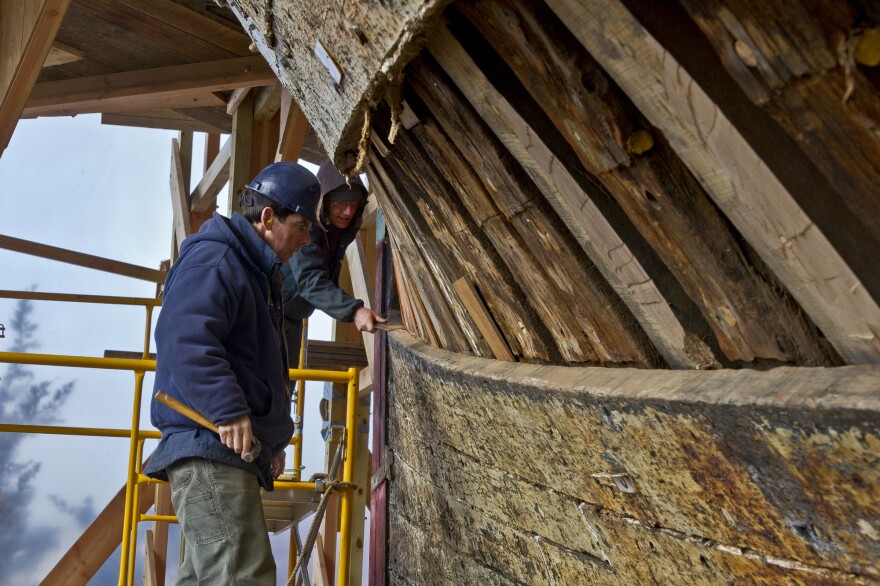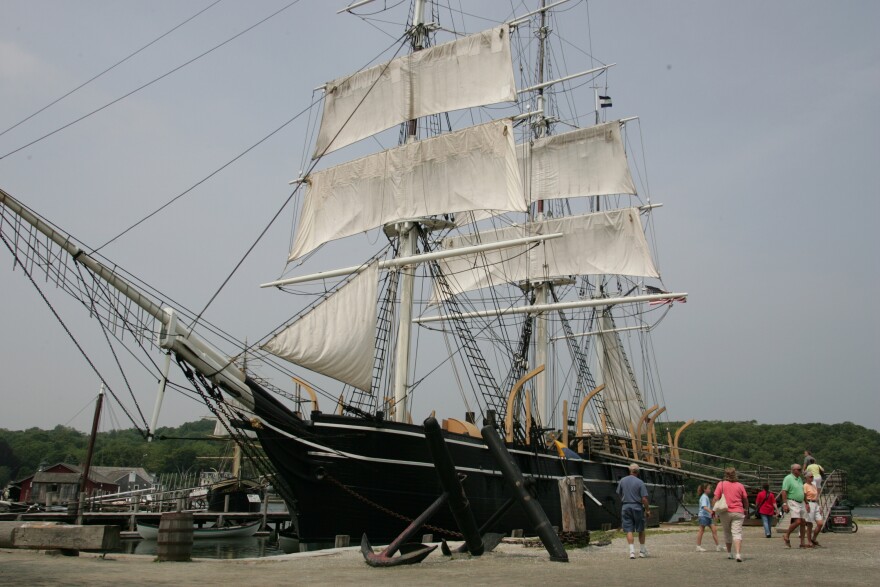"She's built with things that were alive."
Captain Kip Files
The only wooden whaling ship in the world, the Charles W. Morgan, will leave her home port of Mystic Seaport this weekend for the first time in more than 70 years.
This ship, lovingly restored in a painstaking five-year project, will be towed to New London for final commissioning, and the start of her 38th voyage.
If you see Quentin Snediker in Mystic Seaport's shipyard, you won't find him standing in one place for very long. He said, "A good old friend of the museum, a famous naval architect, told me once that all ships are built in the last month. That's where we are: the last few days of the last month."

This weekend, the Morgan will be towed from the Seaport to New London for final commissioning.
For over five years, Snediker has been overseeing the complete restoration of the Charles W. Morgan, the Seaport's flagship, and America's oldest floating commercial vessel. "We're intensely busy," he said, "with not just finishing the details of the woodwork, but we've got riggers, fire..."
Before Snediker had time to finish his list, I had to interrupt him, and ask if we should move somewhere else. "Yeah," he said, after looking over his shoulder. Quickly approaching behind him was a giant fork lift.
Ships carpenters, riggers, electricians, and plumbers have been working over time to prepare the Morgan for her 38th voyage. Listen below to them describe some of what they've been doing:
While she's not quite ready for sea, the work that can be completed here at the shipyard is just about wrapped up. "One of the challenges we face," Snediker said, "is the Mystic River is fairly shallow. By the time she's fit out completely, and ballasted for sea, she's going to be deeper than the River can handle."
This weekend, the Morgan will be towed from the Seaport to New London for final commissioning. In the following weeks, 40 tons of ballast will be added to her bilges, sails bent on, safety tests performed, and her crew will train to sail a vessel which, prior to this restoration, served as a static display for nearly 70 years.
"I mean, she's built with things that were alive," said Captain Kip Files, who signed on last fall as the Morgan's 22nd Captain. "You know, she's a wooden vessel, and the feel of a wooden vessel -- [other] than an iron, steel, or fiberglass vessel -- is different in a seaway. They talk to you differently. The opportunity to take her, and actually move her around, and sail her, and hear those commands again, and the creaking of the decks when she's going through a seaway and stuff, that brings her back to life. It's just another link in the chain of her history."

"This ship is probably at the heart of most people who work at the Seaport."
Sarah Spencer
It's quite a chain. This crew will join the ranks of the Morgan's 1,200 previous sailors, on the last example of more than 2,700 American whalers, which recorded almost 15,000 voyages over 200 years.
"It's the most historic sailing event of historic vessels in my lifetime," Files said. "I don't know how you're going to top it. Think of 1841, when this vessel was built, and then went out to do commercial work. California was part of Mexico -- that far back."
In addition to 15 professional sailors, the Morgan will count a revolving cast of volunteers, and 30 Seaport employees, among her crew for the voyage.
For some, joining the crew brings a lot of emotions. "It's a mingling. It's a little nerve wracking," said Sarah Spencer, who's worked at the museum for 24 years. "I mean, she's the last of her kind in the world, so you hope everything goes just as it should. It's wildly exciting. She's coming alive again. I've climbed on the ship. I've felt the rig in my hands, and under my feet, and hung out on the yards, but to actually do it while she's underway? This ship is probably at the heart of most people who work at the Seaport, and to be a part of that is mind boggling."
More than at the heart of its workers, the Morgan is, in many ways, the heart of the Seaport. Already the last of her kind when she came up the river in 1941, she passed nearly-empty river banks, which had been home to a thriving ship-building industry in the century before.
Her new home had only two buildings on the premises, and just a couple small vessels in the fleet. According to ship's historian Matthew Stackpole, "To have the Morgan be the center of the attention, and have all the energy and talent connected with it, has been invigorating to the museum in a really positive way."

When the Morgan departs this weekend, she'll be leaving a thriving national hub for marine preservation, and will pass numerous marinas and boat yards on those same river banks. For the first time, the home port that grew around her will discover what it feels like to have her gone.
"To take the ship to sea again, to take her on her 38th voyage, is a way to bring attention to all the history that she carries," Stackpole said. "That's her cargo today, and all its multifaceted complicated layers. Some of them are inspiring and exciting, and some of them are terrible that we need to remember so that we don't repeat. but its the whole package, and because she's the real thing, she can help us remember that."
Among the ports of call on her voyage will be New Bedford, where she was built; Martha's Vineyard, which six of her captains called home; and Boston, where she'll dock next to the USS Constitution. She'll also visit the Stellwagen Bank marine sanctuary in search of whales, this time to support their protection. You'll find her back at Mystic Seaport in August.





